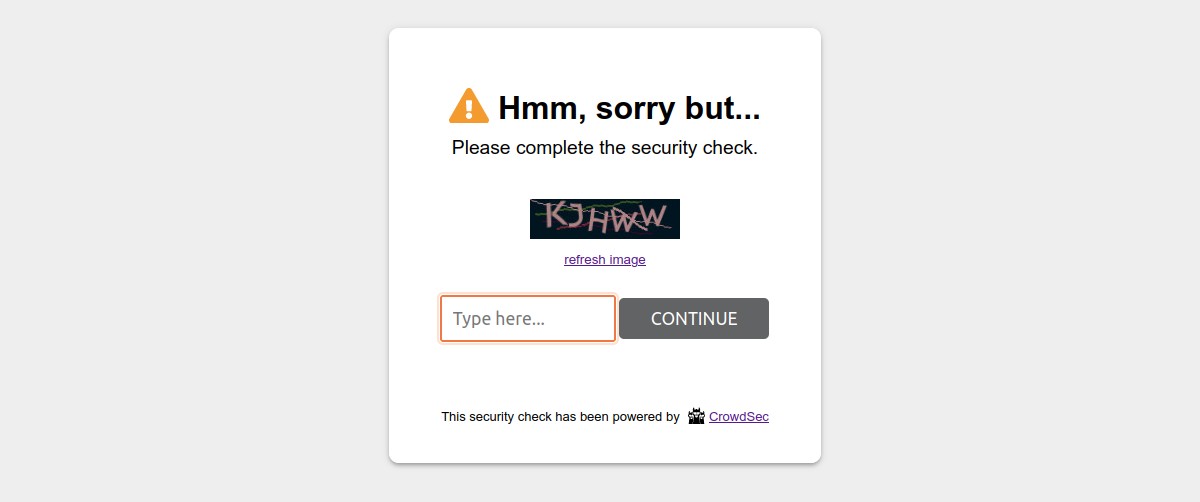PHP Remediation Library

📚 Documentation 💠 Hub 💬 Discourse
Overview
This library allows you to create CrowdSec bouncers for PHP applications or frameworks like e-commerce, blog or other exposed applications.
Installation
Requirements
- PHP >= 7.2.5
- required PHP extensions:
ext-curl,ext-gd,ext-json,ext-mbstring
Installation
Use Composer by simply adding crowdsec/bouncer as a dependency:
composer require crowdsec/bouncer
Usage
Prerequisites
To be able to use a Remediation Component based on this library, the first step is to install CrowdSec v1. CrowdSec is only in charge of the "detection", and won't block anything on its own. You need to deploy a bouncer to "apply" decisions.
Please note that first and foremost a CrowdSec agent must be installed on a server that is accessible by this library.
Features
- CrowdSec Local API support
- Handle
ip,rangeandcountryscoped decisions Live modeorStream mode
- Handle
- Support IpV4 and Ipv6 (Ipv6 range decisions are yet only supported in
Live mode) - Large PHP matrix compatibility: 7.2, 7.3, 7.4, 8.0, 8.1 and 8.2
- Built-in support for the most known cache systems Redis, Memcached and PhpFiles
- Clear, prune and refresh the cache
- Cap remediation level (ex: for sensitives websites: ban will be capped to captcha)
Ban and captcha walls
When a user is suspected by CrowdSec to be malevolent, a component would either display a captcha to resolve or simply a page notifying that access is denied. If the user is considered as a clean user, he/she will access the page as normal.
A ban wall could look like:

A captcha wall could look like:

Please note that it is possible to customize all the colors of these pages so that they integrate best with your design.
On the other hand, all texts are also fully customizable. This will allow you, for example, to present translated pages in your users' language.
Create your own component
Implementation
You can use this library to develop your own PHP application component. Any custom component should extend the AbstractBouncer class.
namespace MyNameSpace;
use CrowdSecBouncer\AbstractBouncer;
class MyCustomBouncer extends AbstractBouncer
{
}
Then, you will have to implement all necessary methods :
namespace MyNameSpace;
use CrowdSecBouncer\AbstractBouncer;
class MyCustomBouncer extends AbstractBouncer
{
/**
* Get current http method
*/
public function getHttpMethod(): string
{
// Your implementation
}
/**
* Get value of an HTTP request header. Ex: "X-Forwarded-For"
*/
public function getHttpRequestHeader(string $name): ?string
{
// Your implementation
}
/**
* Get the value of a posted field.
*/
public function getPostedVariable(string $name): ?string
{
// Your implementation
}
/**
* Get the current IP, even if it's the IP of a proxy
*/
public function getRemoteIp(): string
{
// Your implementation
}
/**
* Get current request uri
*/
public function getRequestUri(): string
{
// Your implementation
}
}
Once you have implemented these methods, you could retrieve all required configurations to instantiate your component
and then call the run method to apply a bounce for the current detected IP. Please see below for
the list of
available configurations.
In order to instantiate the component, you will have to create at least a CrowdSec\RemediationEngine\LapiRemediation
object too.
use MyNameSpace\MyCustomBouncer;
use CrowdSec\RemediationEngine\LapiRemediation;
use CrowdSec\LapiClient\Bouncer as BouncerClient;
use CrowdSec\RemediationEngine\CacheStorage\PhpFiles;
$configs = [...];
$client = new BouncerClient($configs);// @see AbstractBouncer::handleClient method for a basic client creation
$cacheStorage = new PhpFiles($configs);// @see AbstractBouncer::handleCache method for a basic cache storage creation
$remediationEngine = new LapiRemediation($configs, $client, $cacheStorage);
$bouncer = new MyCustomBouncer($configs, $remediationEngine);
$bouncer->run();
Test your component
To test your component, you could add decision to ban your own IP for 5 minutes for example:
cscli decisions add --ip <YOUR_IP> --duration 5m --type ban
You can also test a captcha:
cscli decisions delete --all # be careful with this command!
cscli decisions add --ip <YOUR_IP> --duration 15m --type captcha
To go further and learn how to include this library in your project, you should follow the DEVELOPER GUIDE.
Configurations
The first parameter of the AbstractBouncer class constructor method is an array of settings.
Below is the list of available settings:
Component behavior
-
bouncing_level: Select frombouncing_disabled,normal_bouncingorflex_bouncing. Choose if you want to apply CrowdSec directives (Normal bouncing) or be more permissive (Flex bouncing). With theFlex mode, it is impossible to accidentally block access to your site to people who don’t deserve it. This mode makes it possible to never ban an IP but only to offer a captcha, in the worst-case scenario. -
fallback_remediation: Select frombypass(minimum remediation),captchaorban(maximum remediation). Default to 'captcha'. Handle unknown remediations as. -
trust_ip_forward_array: If you use a CDN, a reverse proxy or a load balancer, set an array of comparable IPs arrays: (example:[['001.002.003.004', '001.002.003.004'], ['005.006.007.008', '005.006.007.008']]for CDNs with IPs1.2.3.4and5.6.7.8). For other IPs, the bouncer will not trust the X-Forwarded-For header. -
excluded_uris: array of URIs that will not be bounced. -
stream_mode: true to enable stream mode, false to enable the live mode. Default to false. By default, thelive modeis enabled. The first time a stranger connects to your website, this mode means that the IP will be checked directly by the CrowdSec API. The rest of your user’s browsing will be even more transparent thanks to the fully customizable cache system. But you can also activate thestream mode. This mode allows you to constantly feed the bouncer with the malicious IP list via a background task (CRON), making it to be even faster when checking the IP of your visitors. Besides, if your site has a lot of unique visitors at the same time, this will not influence the traffic to the API of your CrowdSec instance.
Local API Connection
-
auth_type: Select fromapi_keyandtls. Choose if you want to use an API-KEY or a TLS (pki) authentification. TLS authentication is only available if you use CrowdSec agent with a version superior to 1.4.0. -
api_key: Key generated by the cscli (CrowdSec cli) command likecscli bouncers add bouncer-php-library. Only required if you chooseapi_keyasauth_type. -
tls_cert_path: absolute path to the component certificate (e.g. pem file). Only required if you choosetlsasauth_type. Make sure this path is not publicly accessible. See security note below. -
tls_key_path: Absolute path to the component key (e.g. pem file). Only required if you choosetlsasauth_type. Make sure this path is not publicly accessible. See security note below. -
tls_verify_peer: This option determines whether request handler verifies the authenticity of the peer's certificate. Only required if you choosetlsasauth_type. When negotiating a TLS or SSL connection, the server sends a certificate indicating its identity. Iftls_verify_peeris set to true, request handler verifies whether the certificate is authentic. This trust is based on a chain of digital signatures, rooted in certification authority (CA) certificates you supply using thetls_ca_cert_pathsetting below. -
tls_ca_cert_path: Absolute path to the CA used to process peer verification. Only required if you choosetlsasauth_typeandtls_verify_peeris set to true. Make sure this path is not publicly accessible. See security note below. -
api_url: Define the URL to your Local API server, default tohttp://localhost:8080. -
api_timeout: In seconds. The timeout when calling Local API. Default to 120 sec. If set to a negative value, timeout will be unlimited.
Cache
-
fs_cache_path: Will be used only if you choose PHP file cache as cache storage. Make sure this path is not publicly accessible. See security note below. -
redis_dsn: Will be used only if you choose Redis cache as cache storage. -
memcached_dsn: Will be used only if you choose Memcached as cache storage. -
clean_ip_cache_duration: Set the duration we keep in cache the fact that an IP is clean. In seconds. Defaults to 5. -
bad_ip_cache_duration: Set the duration we keep in cache the fact that an IP is bad. In seconds. Defaults to 20. -
captcha_cache_duration: Set the duration we keep in cache the captcha flow variables for an IP. In seconds. Defaults to 86400.. In seconds. Defaults to 20.
Geolocation
-
geolocation: Settings for geolocation remediation (i.e. country based remediation).-
geolocation[enabled]: true to enable remediation based on country. Default to false. -
geolocation[type]: Geolocation system. Only 'maxmind' is available for the moment. Default tomaxmind. -
geolocation[cache_duration]: This setting will be used to set the lifetime (in seconds) of a cached country associated to an IP. The purpose is to avoid multiple call to the geolocation system (e.g. maxmind database). Default to 86400. Set 0 to disable caching. -
geolocation[maxmind]: MaxMind settings. -
geolocation[maxmind][database_type]: Select fromcountryorcity. Default tocountry. These are the two available MaxMind database types. -
geolocation[maxmind][database_path]: Absolute path to the MaxMind database (e.g. mmdb file) Make sure this path is not publicly accessible. See security note below.
-
Captcha and ban wall settings
-
hide_mentions: true to hide CrowdSec mentions on ban and captcha walls. -
custom_css: Custom css directives for ban and captcha walls -
color: Array of settings for ban and captcha walls colors.-
color[text][primary] -
color[text][secondary] -
color[text][button] -
color[text][error_message] -
color[background][page] -
color[background][container] -
color[background][button] -
color[background][button_hover]
-
-
text: Array of settings for ban and captcha walls texts.-
text[captcha_wall][tab_title] -
text[captcha_wall][title] -
text[captcha_wall][subtitle] -
text[captcha_wall][refresh_image_link] -
text[captcha_wall][captcha_placeholder] -
text[captcha_wall][send_button] -
text[captcha_wall][error_message] -
text[captcha_wall][footer] -
text[ban_wall][tab_title] -
text[ban_wall][title] -
text[ban_wall][subtitle] -
text[ban_wall][footer]
-
Debug
-
debug_mode:trueto enable verbose debug log. Default tofalse. -
disable_prod_log:trueto disable prod log. Default tofalse. -
log_directory_path: Absolute path to store log files. Make sure this path is not publicly accessible. See security note below. -
display_errors: true to stop the process and display errors on browser if any. -
forced_test_ip: Only for test or debug purpose. Default to empty. If not empty, it will be used instead of the real remote ip. -
forced_test_forwarded_ip: Only for test or debug purpose. Default to empty. If not empty, it will be used instead of the real forwarded ip. If set tono_forward, the x-forwarded-for mechanism will not be used at all.
Security note
Some files should not be publicly accessible because they may contain sensitive data:
- Log files
- Cache files of the File system cache
- TLS authentication files
- Geolocation database files
If you define publicly accessible folders in the settings, be sure to add rules to deny access to these files.
In the following example, we will suppose that you use a folder crowdsec with sub-folders logs, cache, tls and geolocation.
If you are using Nginx, you could use the following snippet to modify your website configuration file:
server {
...
...
...
# Deny all attempts to access some folders of the crowdsec remediation lib
location ~ /crowdsec/(logs|cache|tls|geolocation) {
deny all;
}
...
...
}
If you are using Apache, you could add this kind of directive in a .htaccess file:
Redirectmatch 403 crowdsec/logs/
Redirectmatch 403 crowdsec/cache/
Redirectmatch 403 crowdsec/tls/
Redirectmatch 403 crowdsec/geolocation/
N.B.:
- There is no need to protect the
cachefolder if you are using Redis or Memcached cache systems. - There is no need to protect the
logsfolder if you disable debug and prod logging. - There is no need to protect the
tlsfolder if you use remediation API key authentication type. - There is no need to protect the
geolocationfolder if you don't use the geolocation feature.
Other ready to use PHP bouncers
To have a more concrete idea on how to develop a bouncer from this library, you may look at the following bouncers :
- CrowdSec Bouncer extension for Magento 2
- CrowdSec Bouncer plugin for WordPress
- CrowdSec Standalone Bouncer
Technical notes
See Technical notes
Developer guide
See Developer guide

